 Biological Microscope:- When it comes to microscopy, it is a wide market one will step into, where tiny structures become visible to your naked eyes! In biology labs, microscopes serve as our windows into the hidden realms of cells, tissues, and microorganisms. These incredible instruments come in various shapes and sizes, each designed for specific tasks. From the classic light microscope to the cutting-edge electron microscope, there’s a tool for every scientific inquiry. As microscopic equipment got better, more and more biological microscopes with full features were made so that scientists could study biological objects better. This kind of microscope is longer than a regular trinocular compound microscope.
Biological Microscope:- When it comes to microscopy, it is a wide market one will step into, where tiny structures become visible to your naked eyes! In biology labs, microscopes serve as our windows into the hidden realms of cells, tissues, and microorganisms. These incredible instruments come in various shapes and sizes, each designed for specific tasks. From the classic light microscope to the cutting-edge electron microscope, there’s a tool for every scientific inquiry. As microscopic equipment got better, more and more biological microscopes with full features were made so that scientists could study biological objects better. This kind of microscope is longer than a regular trinocular compound microscope.
There are different kinds of microscopes. Some have higher resolutions, like phase contrast microscopes, while others have lower resolutions, like simple upright and slanted microscopes. To look at cells and growth, you should always use the best trinocular microscope.
As was already said, different kinds of microscopes are used to get information from biological cells and organs.
- Light Microscopes: These are the most common type. They use visible light and lenses to magnify small objects, such as cells and tissues.
- Compound Microscopes: These have multiple lenses for high magnification. They’re used for viewing thin slices of specimens.
- Stereo Microscopes: Also called dissecting microscopes, they provide a 3D view of larger specimens like insects or plants. They’re often used for dissections.
- Fluorescence Microscopes: These use fluorescent light to highlight specific parts of a specimen, such as certain molecules or proteins within cells.
- Electron Microscopes: These use a beam of electrons instead of light to magnify objects. They offer much higher magnification and resolution, allowing for the study of smaller structures like viruses and molecules.
- Transmission Electron Microscopes (TEM): They transmit electrons through a specimen to create an image. They’re used to study internal structures of cells and viruses.
- Scanning Electron Microscopes (SEM): These scan a specimen with a focused beam of electrons to create a detailed 3D image of its surface.
- Confocal Microscopes: They use lasers to scan fluorescently labeled specimens and create high-resolution 3D images.
- Phase-Contrast Microscopes: These enhance the contrast of transparent specimens, making them easier to see without staining.
- Darkfield Microscopes: They use a special lighting technique to create contrast against a bright background, useful for viewing live bacteria or other transparent specimens.
Each type of microscope has its advantages and is used for specific purposes in biological research and study.
Importance of Microscopes
Sure, here’s the information broken down into simple points:
- Discovering the Unseen: Microscopes help us see things that are too tiny for our eyes to notice, like cells and bacteria.
- Understanding Cells: They allow scientists to study the structure and functions of cells, which are the basic building blocks of all living things.
- Investigating Diseases: Microscopes help in diagnosing diseases by examining tissues and blood samples for abnormalities.
- Advancing Medicine: By observing microorganisms, researchers can develop treatments and vaccines to fight diseases.
- Environmental Studies: Scientists use microscopes to study tiny organisms in ecosystems, helping to understand and preserve natural habitats.
- Quality Control: Microscopes are used in industries like food and pharmaceuticals to ensure products meet safety standards by checking for contaminants.
- Innovating Technology: Microscopy techniques drive innovations in fields like nanotechnology, where tiny structures are manipulated for various applications.
- Educational Tool: Microscopes are essential in classrooms, allowing students to explore the microscopic world first-hand, fostering curiosity and learning.
Wrapping up!
From the above conversation, we got to know about the various types of microscopes that are used in bio labs. If you are looking for the best biological microscope manufacturers, you can join hands with Quasmo Microscope for better and top-quality products.
